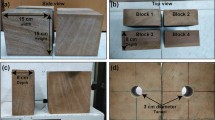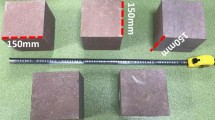Abstract
Rockburst is one of the most difficult problems encountered in the pilot tunnels of the Jinping II hydropower station, where the rock cover is up to 2,500 m. Some typical characteristics of the rockburst events are summarized. These events indicate the intrinsic reason of rockburst is energy release. In order to understand the outburst mechanism, a new energy index, the Local Energy Release Rate (LERR), is put forward to simulate the conditions causing rockburst. By tracking the peak and trough values of elastic strain energy intensity before and after brittle failure, the LERR was developed to help understand rockburst from the viewpoint of energy release. To test its reliability, the brittle breakage of Mine-by tunnel rock in Canada and two rock bursts in the Jinping pilot tunnels were simulated. The results showed that LERR can satisfactorily predict the intensity of a rockburst and the depth of the outburst pit. Although it is not yet possible to determine thresholds at which rockbursts will occur, the study indicates the potential of LERR for evaluating rockbursts in deep underground excavations.
Résumé
La décompression violente est l’un des plus difficiles problèmes rencontrés dans les galeries de reconnaissance de la station hydroélectrique de Jinping I ou la hauteur de recouvrement est de 2,500 m. Quelques caractéristiques typiques des événements de décompression violente sont résumées. Afin de comprendre le mécanisme de décompression, un nouvel indice d’énergie, le taux de dissipation locale d’énergie (LERR) est proposé pour représenter les conditions favorisant la décompression violente. Le LERR a été développé à partir de l’analyse de la valeur de pic et la valeur minimale de l’intensité d’énergie de déformation élastique avant et après la rupture fragile, aidant ainsi à comprendre la décompression violente du point de vue de la dissipation d’énergie. Afin de tester sa fiabilité, la rupture fragile de galeries minières au Canada et deux décompressions violentes dans les galeries de reconnaissance de Jinping ont été simulées. Les résultats ont montré que le LERR peut prévoir de façon satisfaisante les intensités de décompression violente et la profondeur où elle peut apparaître. Bien qu’il ne soit pas encore possible de déterminer les seuils pour lesquels les décompressions violentes apparaîtront, l’étude précise l’intérêt du LERR pour évaluer ces phénomènes dans les excavations souterraines profondes.













Similar content being viewed by others
References
Brady BT, Leighton FW (1977) Seismicity anomaly prior to anomaly prior to a moderate rock burst–case study. Int J Rock Mech Min Sci 14(3):127–132
Casten U, Fajklewicz Z (1993) Induced gravity-anomalies and rock-burst risk in coal–mines–a case history. Geophys Prospect 41(1):1–13
Chakrabarty J (1987) Theory of elasticity. McGRAW HILL, New York
Cook NGW, Hoek E, Pretorius JPG et al (1966) Rock mechanics applied to the study of rockbursts. SAIMM 66(10):436–528
Hagan TO (1988) Pillar foundation failure studies at a deep South African gold mine. In: Proceedings of the 2nd international symposium of rockbursts and seismicity in mines, Minneapolis, pp 51–61
Hajiabdolmajid V, Kaiser PK, Martin CD (2002) Modeling brittle failure of rock. Int J Rock Mech Min Sci 39:731–741
Heunis R (1980) The development of rock-burst control strategies for South-African-gold mines. J S Afr Inst Min Metall 80(4):139–150
Hirata A, Ishiyama K, Taga N et al (1991) AE Monitoring and rock stress measurement in rock burst site. In: 7th International congress on rock mechanics, vol 1. Rock mechanics and environmental protection, pp 505–508
Hua AZ, You MQ (2001) Rock failure due to energy release during unloading and application to underground rock burst control. Tunn Undergr Space Technol 16:241–246
Jiang Q, Feng XT, Chen GQ (2008) Study on deterioration model for hard rockmass under high geo-stress. In: Fan JH, Chen HB (eds) Advance in heterogeneous material mechanics 2008, China, pp 1108–1112
Kaiser PK, McCreat DR, Tannnant DD (1996) In: Canadian rockburst support handbook, Geomechanics Research Centre
Li ZH, Dou LM, Lu CP et al (2008) Study on fault induced rock bursts. J China Univ Min Technol 18:0321–0326
Linkov AM (1996) Rockburst and the instability of rock masses. Int J Rock Mech Min Sci Abstr 33:727–732
Mansurov VA (2001) Prediction of rockbursts by analysis of induced seismicity data. Int J Rock Mech Min Sci 38(6):893–901
Owen DRJ, Hinton E (1980) Finite elements in plasticity in theory and practice. Pineridge Press, Swansea
Read RS (2004) 20 years of excavation response studies at AECL’s Underground Research Laboratory. Int J Rock Mech Min Sci 41:1251–1275
Shivakumar K, Rao MVMS, Srinivasan C et al (1996) Multifractal analysis of the spatial distribution of area rockbursts at Kolar Gold Mines. Int J Rock Mech Min Sci Abstr 33(2):167–172
Sun JS, Zhu QH, Li WB (2007) Numerical simulation of rock burst in circular tunnels under unloading conditions. J China Univ Min Technol 17:0552–0556
Tajdus A, Majcherczyk T, Cala M (1996) Effect of fault on rockbursts hazard. In: Rakowski Z (ed) Geomechanics. Balkema, Rotterdam
Wang JA, Park HD (2001) Comprehensive prediction of rockburst based on analysis of strain energy in rocks. Tunn Undergr Space Technol 16(1):49–57
Wu SY, Wang J, Wang G (2007) Underground water and its treatment strategy. Chin J Rock Mech Eng 26(10):1959–1968
Zubelewicz A, Mroz Z (1983) Numerical-simulation of rock burst processes treaded as problems of dynamic instability. Rock Mech Rock Eng 16(4):253–274
Acknowledgments
The work is financially supported by National Special Funds for Major State Basic Research Project under Grant No. 2010CB732006 and Natural Science Foundation of China under Grant No. 40902090. In particular we wish to thank J. Hou, Q. H. Zhou, C. Q. Zhang, and S. L. Huang for their contributions to this paper.
Author information
Authors and Affiliations
Corresponding author
Rights and permissions
About this article
Cite this article
Jiang, Q., Feng, XT., Xiang, TB. et al. Rockburst characteristics and numerical simulation based on a new energy index: a case study of a tunnel at 2,500 m depth. Bull Eng Geol Environ 69, 381–388 (2010). https://doi.org/10.1007/s10064-010-0275-1
Received:
Accepted:
Published:
Issue Date:
DOI: https://doi.org/10.1007/s10064-010-0275-1




